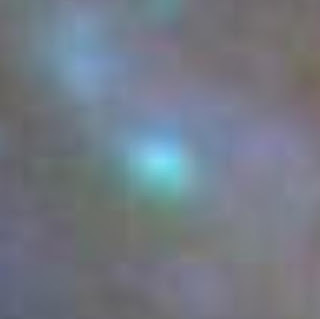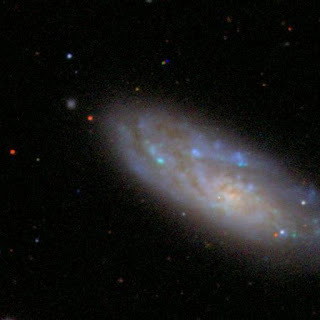GalaxyZoo Tool Use
Use GalaxyZoo: don't just explore the world, explore the *Universe*!
So I ask for a galaxy, and at first all I saw was this:

"That's not a galaxy", says I. "I wonder what it really is?"
So I clicked through to the SkyServer Object Explorer page via the "Galaxy Ref:" link. Here I was disappointed to see the words, No scienceprimary SpecObj linked to this PhotoObj, which means they don't have a spectrum for the object and thus we don't know how far away it is. I then clicked on the image on that page, to get a bigger picture with the SDSS Finding Chart Tool:

Oh. I guess it is a galaxy, all right.
I wondered if some other part of this galaxy might have had its spectrum taken, so I went to the Navigate Tool, which is reachable both from the Object Explorer page (under PhotoObj on the left navigation bar) and from Finding Chart (as Navi, just below the DR6 logo).
On Navigate, the object you're looking at is outlined with a green box. One of the useful things to do here is to check the box under "Drawing options" for "Objects with spectra". When you do that, red boxes go around every object in the view for which there is spectroscopic data. This is extremely important, because the spectrum summary tells you (a) whether the object is really a galaxy at all, and (b) if so, how far away it is.
If there *is* a red spectrum box, you can click it in Navigator to select that object, then get to the new Object Explorer page by clicking "Explore" over the right.
In this case, I was surprised to find that there don't seem to be any parts of this galaxy with a spectrum (and thus distance), but since it takes up the most screen space of any galaxy I've stumbled upon yet, I assume it's pretty close by the standards of the universe.
I don't know (yet!) how to find out whether this galaxy has a NGC number or other "scientific name". I don't even know how to go from the RA/Dec parameters SDSS gives in degrees to the more usual hr:min:sec, so I can figure out what constellation this might be in. While I was exploring I noticed that there's a very bright, probably naked-eye-visible star to the South of this galaxy, at 190.417,-1.457, but I don't know how to convert that to more conventional coordinates, either. If you know, tell me!
So I ask for a galaxy, and at first all I saw was this:

"That's not a galaxy", says I. "I wonder what it really is?"
So I clicked through to the SkyServer Object Explorer page via the "Galaxy Ref:" link. Here I was disappointed to see the words, No scienceprimary SpecObj linked to this PhotoObj, which means they don't have a spectrum for the object and thus we don't know how far away it is. I then clicked on the image on that page, to get a bigger picture with the SDSS Finding Chart Tool:

Oh. I guess it is a galaxy, all right.
I wondered if some other part of this galaxy might have had its spectrum taken, so I went to the Navigate Tool, which is reachable both from the Object Explorer page (under PhotoObj on the left navigation bar) and from Finding Chart (as Navi, just below the DR6 logo).
On Navigate, the object you're looking at is outlined with a green box. One of the useful things to do here is to check the box under "Drawing options" for "Objects with spectra". When you do that, red boxes go around every object in the view for which there is spectroscopic data. This is extremely important, because the spectrum summary tells you (a) whether the object is really a galaxy at all, and (b) if so, how far away it is.
If there *is* a red spectrum box, you can click it in Navigator to select that object, then get to the new Object Explorer page by clicking "Explore" over the right.
In this case, I was surprised to find that there don't seem to be any parts of this galaxy with a spectrum (and thus distance), but since it takes up the most screen space of any galaxy I've stumbled upon yet, I assume it's pretty close by the standards of the universe.
I don't know (yet!) how to find out whether this galaxy has a NGC number or other "scientific name". I don't even know how to go from the RA/Dec parameters SDSS gives in degrees to the more usual hr:min:sec, so I can figure out what constellation this might be in. While I was exploring I noticed that there's a very bright, probably naked-eye-visible star to the South of this galaxy, at 190.417,-1.457, but I don't know how to convert that to more conventional coordinates, either. If you know, tell me!
Labels: closeby, galaxyzoo, galaxyzoo skillz, spiral



